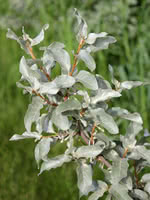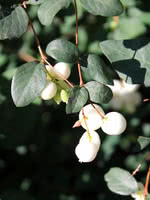Mon-Fri 9am - 5pm Mountain time
Silverberry (Wolf Willow) vs Western Snowberry
Elaeagnus commutata
Symphoricarpos occidentalis
NOT AVAILABLE THIS SEASON - MIGHT RETURN
Silverberry (also known as Wolf Willow) is a common native North American shrub. This beautiful ornamental plant has characteristic silver leaves and fragrant yellow flowers.
Its silver berries remain on the branches through the winter. Silverberry is cold hardy and has some ability as a nitrogen fixer. It can grow on dry to moist sandy/gravel soils. This plant is very low maintenance.
Like the Common Snowberry, the Western Snowberry is a small shrub with pink flowers useful for feeding livestock and preventing erosion. Unlike the common species, however, the Western Snowberry is much more suited to wet conditions, capable of persevering through poor soil drainage and occasional flooding.
After the Snowberry's flowers have bloomed, it produces berries which often last on the plant through winter. These berries are toxic to humans, but livestock and local wildlife love them! Those hoping to attract wildlife to their property can plant Snowberry and expect to see animals foraging on it much later in the year than other plants.
Silverberry (Wolf Willow) Quick Facts
Western Snowberry Quick Facts
Toxicity: berries are toxic to humans

